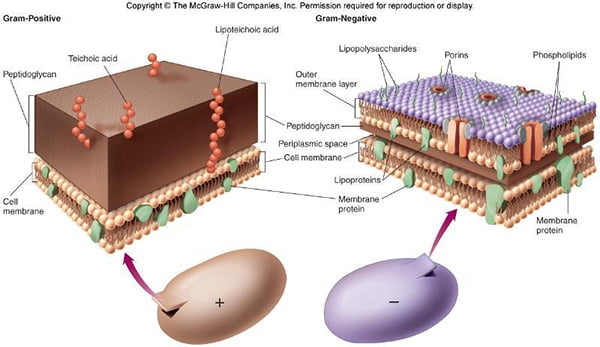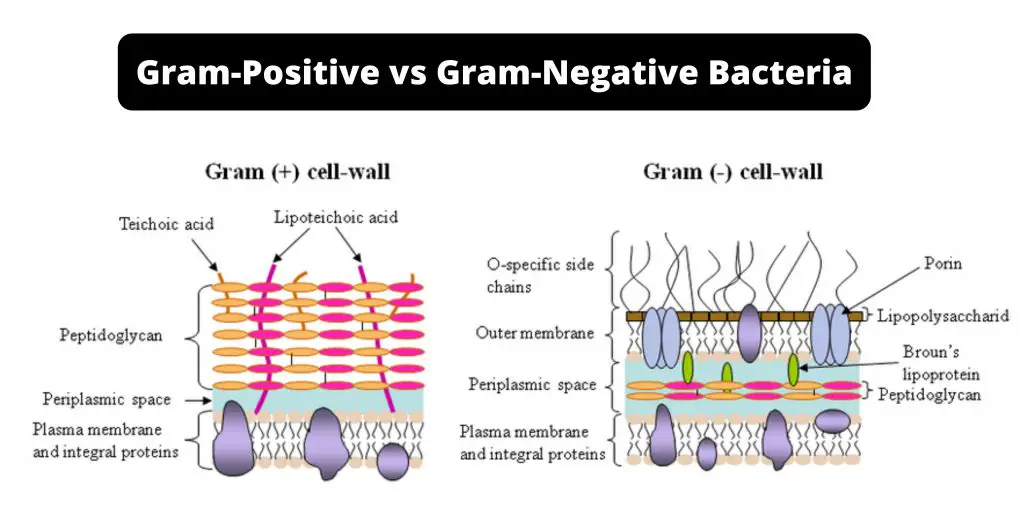Explain the Structural Differences Between Gram and Gram Bacteria
Use APA guidelines for proper. Microbiology Explain the differences between gram-positive and gram-negative cell walls of bacteria and compare them with the cell walls of archaeobacteria and mycoplasmas.

Differences Between Gram Positive And Gram Negative Bacteria
Teichoic acids and phosphate are also found in its cell wall.

. Peptidogylcan also called murein. Its 20 to 80 nanometers thick. Write an essay about the structural differences between Gram-positive and Gram-negative bacteria cell walls.
Describe the structure and functions of the prokaryotic. Cell Wall is single layered straight even less elastic and more rigid and the rigidity of the cell wall is due to the high amount of. Gram positive cell wall retain the primary stain of Gram staining crystal violet and appear purple after alcohol treatment.
It is present only in plant cells and also seen in some fungi bacteria and algae. Differences between gram-positive and gram-negative organisms. The cell wall structure of Gram negative bacteria is more complex than that of Gram positive bacteria.
The key difference between gram positive and gram negative cell wall is that the gram positive cell wall has a thick peptidoglycan layer with teichoic acids while gram negative cell wall has a thin peptidoglycan layer surrounded by an outer membrane. Cell wall is single layered and primarily made up of peptidoglycan. The gram reaction of gram-positive bacteria is that it retain crystal violet dye and stain blue or purple while gram-negative bacteria accept safranin and stain pink or red.
Include the fluid mosaic model in your description Differentiate between prokaryotic cells and eukaryotic. The cell wall is the outermost and non-living part of the cell. Cell wall of Gram negative bacteria.
During the gram staining procedure a gram-positive cell retains the purple-colored stain. Located between the plasma membrane and the thin peptidoglycan layer is a gel-like matrix called periplasmic space. Biology questions and answers.
Explain major structural differences in the cell envelope between Gram positive and gram negative bacteria ex. Cell walls are made up of peptidoglycan also known as murein. Cell Wall Structure in Gram Positive Bacteria.
Explain what would happen to the cell walls physical integrity while applying the Gram staining technique. In gram-negative cells there are two structures that need to be mentioned. Peptidoglycans have a glycan backbone that is composed of both N-acetylated Muramic acid and the glucosamine.
But do not retain the purple colored stain. What are the chemical structural differences between the cell walls of gram-positive and gram- negative bacteria that might explain differences in the rate of decolorization. The cell wall of gram-positive bacteria is made up of numerous layers of peptidoglycan that form a hard and thick structure.
We are not referring to the gram stain procedure. Unlike in Gram positive bacteria Gram negative bacteria have an outer membrane layer that is external to the peptidoglycan cell wall. Write an essay about the structural differences between Gram-positive and Gram-negative bacteria cell walls.
The cell wall of gram-positive bacteria is consisting of thick layers of peptidoglycan. 28 rows Differences Between Gram Positive and Gram Negative Bacteria. Gram negative bacteria have less peptidoglycan in their cell wall so cannot retain crystal violet dye so they stain red-pink.
Cell wall is double layered and with an outer membrane outside to Peptidoglycan layer. The thickness of the gram-positive bacteria cell wall is about 20 to 80 nanometres while that of gram-negative bacteria is about 8 to 10 nanometres. Structure of bacterial cytoplasmic membranes.
Difference Between Gram-Positive and Negative Cell Wall. The Gram staining technique is dependent on the characteristics of the cell wall. The structural difference between gram positive and gram negative bacterial cells that result in the different colors is gram positive cells have a thick peptidoglycan layer with no outer lipid membrane while gram negative bacteria have a thinner peptidoglycan layer and an.
Explain what would happen to the cell walls physical integrity while applying the Gram staining technique. Peptidoglycan which is around 80 in gram-positive bacteria whereas in gram-negative bacteria the cell wall is bi-layered wavy uneven. Thickness of peptidoglycan layer teichoic acids outer membrane LPS STUDY.
Lipoteichoic acid and teichoic wall acid are the two forms of teichoic acid found in gram-positive bacteria. Cell wall is made of. The cell wall is a thick rigid semi-permeable membrane and has elastic properties that help them to grow in thickness over the period of time.
Use APA guidelines for proper. Gram positive bacteria have lots of peptidoglycan in their cell wall which allows them to retain crystal violet dye so they stain purple-blue. The Gram staining technique is dependent on the characteristics of the cell wall.
Another major difference between gram positive and gram negative cell wall is that the gram positive cell wall stains in. Gram positive bacteria possess the cell wall that is continuous called the sacculus. 22 rows the difference is clear but in simple explanation gram staining is what makes bacteria to be gram positive or negative and this happens because gram positive bacteria have thick peptidoglycan which retains crystal violet staining dye as opposed to gram.
Explain what would happen to the cell walls physical integrity while applying the Gram staining technique. Whereas the cell wall of gram-negative bacteria is consisting of thin layers of peptidoglycan.

Gram Positive Vs Gram Negative Technology Networks

Difference Between Gram Positive And Negative Bacteria Gram Negative Vs Gram Po Bacteria

Major Difference Between Gram Positive And Gram Negative Bacteria
Comments
Post a Comment